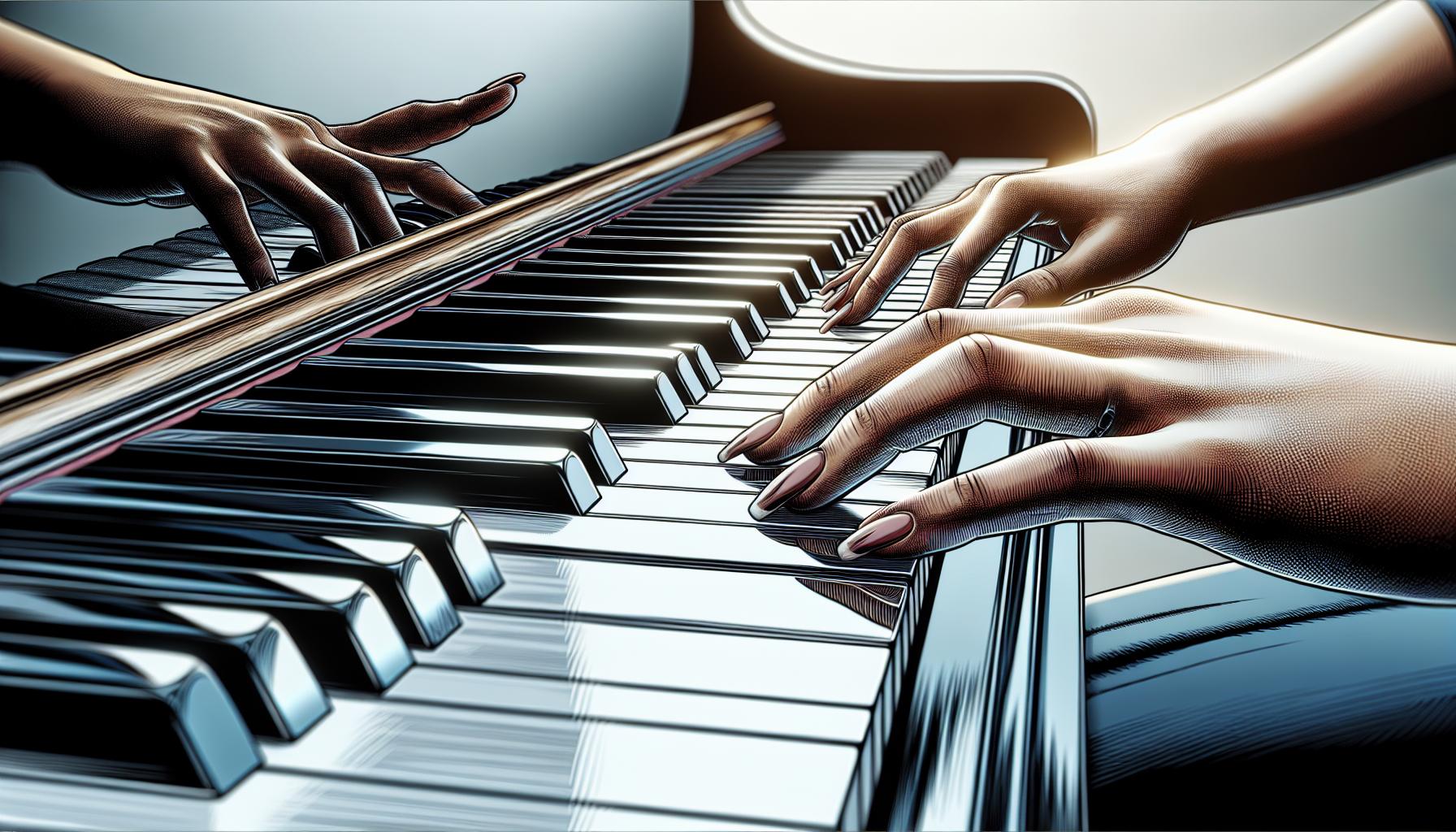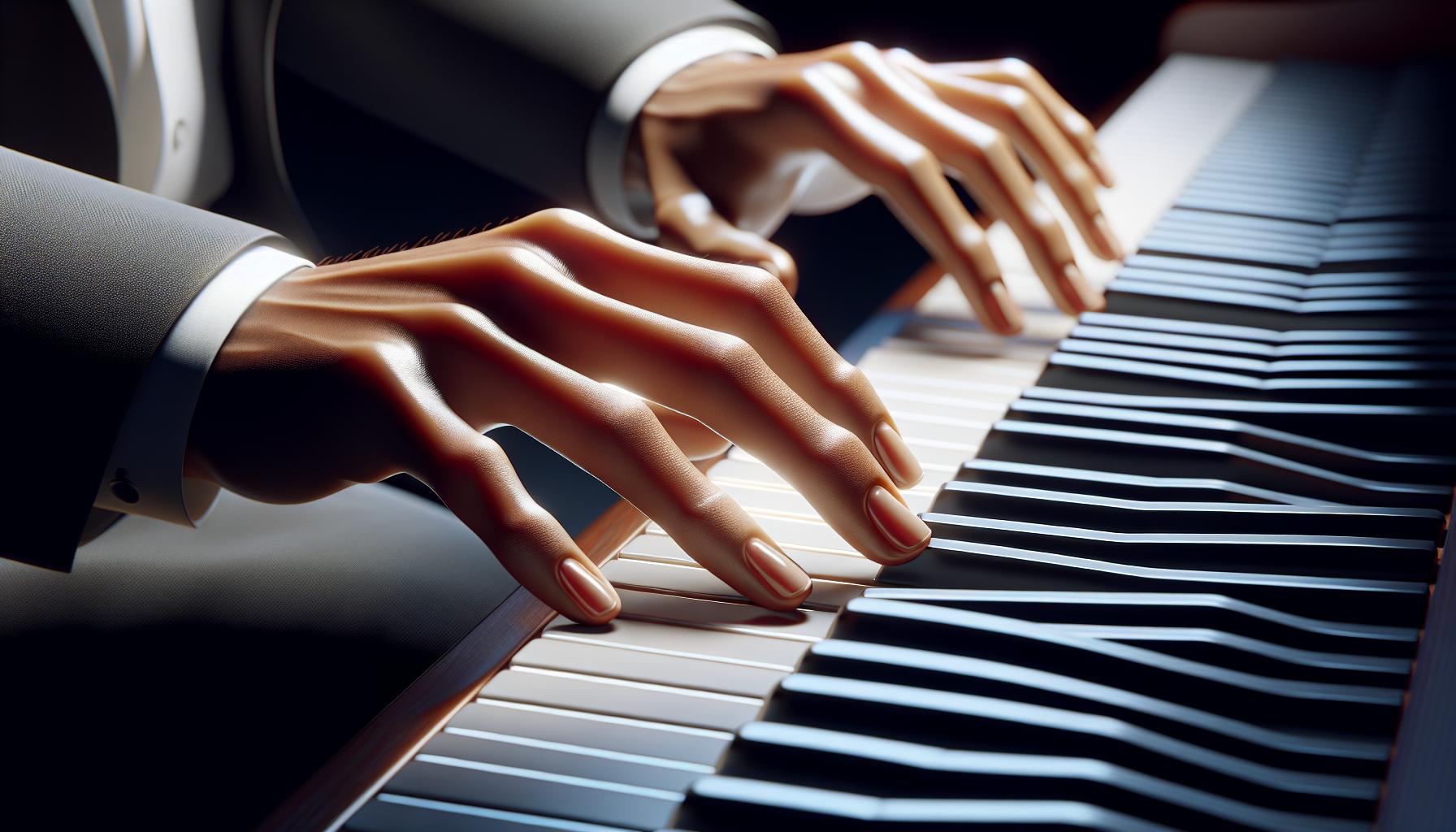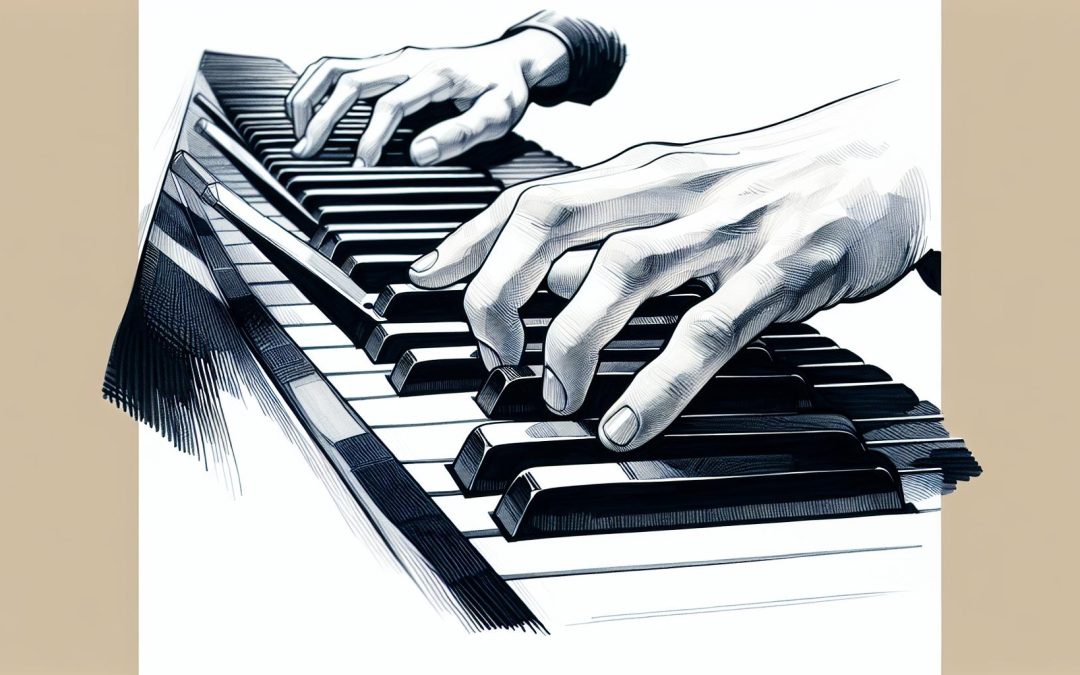Learning to play the piano is like embarking on a musical journey, filled with highs, lows, and everything in between. For beginners, it's a world where melodies come to life under their fingertips. However, it's not without its challenges. One of the most common hurdles they face is mastering the art of piano fingering. It's the foundation upon which beautiful music is built, yet it's often where many stumble.
From using the wrong fingers for certain keys to inconsistent hand positioning, these mistakes can turn a harmonious experience into a frustrating one. They not only affect the quality of the music but can also lead to bad habits that are hard to break. Let's dive into the world of piano fingering mistakes, shedding light on these common blunders so beginners can sidestep them and continue making beautiful music.
Using Incorrect Fingers for Keys
One of the most prevalent challenges that beginners face when learning to play the piano is using incorrect fingers for keys. This mistake often stems from a lack of understanding of proper fingering techniques which are crucial for efficient and fluid piano playing. Proper fingering allows for smoother transitions between notes, keeps the hand in a comfortable position, and ultimately contributes to a more pleasant musical sound.
At the heart of this issue is the tendency for beginners to use whatever finger feels most convenient at the moment without considering the musical phrases that follow. For instance, they might use their thumb to play a key because it's nearest, not realizing that it traps the hand in an awkward position for the next sequence of notes. This can lead to choppy and disjointed music rather than a smooth, flowing melody.
To illustrate, here's a common scenario:
- A beginner attempts to play a scale or a simple melody.
- They start with proper fingering but soon resort to using random fingers.
- The music sounds uneven, and they struggle to transition smoothly between notes.
Correct Fingering is Crucial
Learning and adhering to correct fingering is not merely a suggestion; it's a necessity for anyone wishing to play the piano well. Every piece of piano music has fingering suggestions that cater to the most natural hand movements and transitions. Ignoring these suggestions often results in inefficient hand positions and movements, leading to increased difficulty with speed and accuracy as the music becomes more complex.
- Using the same finger for consecutive notes: This can severely limit the fluidity of the music.
- Overusing the thumb or pinky: Relying too much on these fingers can lead to awkward transitions.
- Not using the full hand: Failing to utilize all fingers leads to unnecessary hand movements.
To combat these mistakes, teachers often emphasize the importance of slow, deliberate practice with a focus on proper fingering from the very beginning. It's not uncommon for beginners to find this approach tedious, but the payoff is undeniable. As muscle memory develops, the correct finger placements start to feel more natural, and the quality of the music improves markedly.
Additionally, various exercises, such as scales and arpeggios, are designed to reinforce correct fingering patterns. These exercises not only help in mastering the movements of the fingers across the keyboard but also in understanding the reasoning behind each fingering choice.
Poor Hand Positioning

One major obstacle that often impedes a beginner pianist's progress is Poor Hand Positioning. Proper hand placement isn't just about aesthetics; it's a fundamental aspect that influences the ease with which one can reach the keys and transition smoothly between notes. Without correct positioning, players find themselves struggling with even the simplest of pieces, rendering their practice sessions less effective and far more frustrating than they need to be.
For starters, the wrists should remain flexible yet stable, allowing the fingers to glide across the keyboard with minimal effort. A common mistake is either elevating the wrists too high or letting them drop too low, both of which can lead to unnecessary tension in the hands and forearms. This tension not only hampers movement but can also contribute to long-term discomfort or even injury. Additionally, fingers should curve slightly, as though cupping an invisible ball, to strike the keys with their pads rather than their tips or sides. This position optimizes control and touch sensitivity, enabling nuances in dynamics and articulation.
Another aspect often overlooked is the angle of the arms. Ideally, they should form a roughly straight line from the elbow through the wrist to the hand, without any sharp bends. Such alignment ensures that the force applied when pressing the keys comes from the arms and the body, not just the fingers, preventing fatigue and promoting endurance.
Beginners might also misjudge their distance from the keyboard, either crowding too close or stretching too far. A comfortable distance allows the arms to extend slightly forward, so the fingers can reach all the keys without strain. Adjusting the bench height and location can make a significant difference in achieving this optimal positioning.
To correct these common mistakes, beginners are encouraged to:
- Keep their wrists flexible and at a moderate height
- Curve their fingers for better control
- Maintain a straight arm line for efficient force use
- Adjust their sitting distance for comfortable reach
Incorporating these adjustments requires mindfulness and patience, as old habits can be hard to break. Regular monitoring and adjustments can help ensure that proper hand positioning becomes a natural part of a pianist's technique. Visual aids, such as mirrors placed to the side of the keyboard, can offer immediate feedback on one's posture and hand shape, serving as a useful tool during practice.
Neglecting Finger Independence

One often overlooked aspect of learning the piano is developing finger independence. Many beginners find themselves struggling with pieces that require simultaneous action from multiple fingers, each moving in its own rhythm and direction. Finger independence is crucial for executing complex melodies and harmonies that are the hallmark of proficient piano playing. Without it, players are likely to hit a plateau early on in their learning journey.
The root of this problem lies in the natural tendency of fingers to move in sympathy with one another. It’s common for beginners to move fingers in a group or to rely heavily on their dominant fingers, neglecting the weaker ones. This leads to a lack of control and precision when playing. To combat this, it's essential for pianists to engage in specific exercises that target the independence of each finger. These exercises, often simple and repetitive, can significantly improve dexterity and control over time.
- Daily Exercises: Incorporating finger independence exercises into daily practice is vital. Scales, arpeggios, and Hanon exercises are particularly effective in isolating each finger’s movements.
- Slow Practice: Playing slowly allows for the conscious correction of finger movements, ensuring that each finger acts independently of the others.
- Varied Dynamics: Practicing the same piece or exercise with different dynamics (loud, soft, crescendo, decrescendo) for each finger further enhances control and independence.
Here’s a brief overview of exercises to improve finger independence:
| Exercise Type | Description | Benefit |
|---|---|---|
| Scales | Playing scales slowly and precisely. | Improves strength and agility. |
| Arpeggios | Breaking chords into single notes. | Enhances reach and precision. |
| Hanon | Specific exercises for finger control. | Builds endurance and dexterity. |
Encouraging beginners to focus on these aspects can lead to a significant improvement not just in their ability to play complex pieces but in their overall technique as well. It's not just about playing notes accurately but playing them with the right expression, timing, and dynamics. Developing finger independence is a stepping stone towards achieving that musicality and technical skill.
Overlooking Finger Strength and Agility

For many beginners at the piano, there's a tendency to focus solely on learning the notes and perfecting rhythm. While these are undoubtedly crucial aspects of playing the piano, novices often overlook the importance of finger strength and agility. This oversight can lead to a host of issues that might hinder their progress and limit their expressive capabilities on the instrument.
Finger strength and agility are the bedrock of good piano technique. They enable pianists to execute complex passages, maintain evenness in scales and arpeggios, and produce a wide range of dynamics and articulations. Without robust finger development, players may find themselves struggling with inconsistency and unevenness in their playing.
Common Missteps in Developing Finger Strength and Agility
One frequent mistake is the over-reliance on certain fingers, especially the thumb and index finger, which are naturally stronger. This imbalance often leaves the weaker fingers lagging, leading to uneven scales and chords. Another oversight is not dedicating time to specific exercises aimed at building finger independence and control. Practices such as scales, arpeggios, and Hanon exercises are essential for cultivating the agility and strength required to tackle more challenging repertoire.
In addition to neglecting specific technical exercises, beginners might not realize the role that slow practice plays in enhancing finger strength and agility. Playing slowly allows pianists to concentrate on the equal contribution of each finger, ensuring that none are overworked or ignored. This careful, deliberate approach to practice lays a solid foundation for more advanced skills.
Furthermore, varying dynamics during practice is another aspect often overlooked by novices. They might not appreciate how playing passages at different volumes can significantly improve finger control and sensitivity. Soft playing, in particular, demands a high level of precision and strength, as it requires the pianist to depress the keys with enough force to sound a note while controlling the pressure to keep the volume low.
- Scales and Arpeggios: Practice them slowly, focusing on evenness and control. Gradually increase the speed while maintaining precision.
- Hanon and Czerny Exercises: These classical exercises are designed to improve finger strength and independence. They should be played with attention to detail, adhering to recommended fingerings.
- **Stacc
Failing to Practice Scales and Arpeggios

One of the most common piano fingering mistakes for beginners is skipping over the practice of scales and arpeggios. It's often seen as monotonous or less engaging compared to learning new songs. However, this overlooks their fundamental importance in developing not only finger agility and strength but also in understanding musical keys and improving sight-reading skills.
Scales and arpeggios are the building blocks of music. They provide pianists with a framework to understand and play various pieces more effectively. When beginners ignore these exercises, they miss the chance to familiarize themselves with patterns that recur in compositions. This can lead to difficulties in playing more complex pieces that require a strong knowledge of scales and the ability to navigate the keyboard effortlessly.
Moreover, practicing scales and arpeggios contributes significantly to finger independence. Each finger is trained to move with precision and strength, reducing the reliance on more dominant fingers, which is a common pitfall among beginners. The repetitive nature of these exercises also enhances muscle memory, making it easier for pianists to execute pieces without the need to constantly look at their hands.
The Importance of Correct Fingering
The right fingering technique is crucial when practicing scales and arpeggios. Incorrect fingering can lead to bad habits that are hard to unlearn and may hinder a pianist's progress. Each scale and arpeggio has recommended fingering that aims to make the execution as smooth and efficient as possible. They're designed to ensure that hand movements across the keyboard are fluid, minimizing awkward hand positions that can lead to strain or injury.
Beginners might find it tempting to use fingering that feels more comfortable in the short term but doing so can limit their playing speed and expression in the long run. Adhering to the recommended fingering patterns encourages pianists to develop a versatile technique that's applicable to a wide variety of musical contexts.
Incorporating Scales and Arpeggios into Daily Practice
Including scales and arpeggios in daily practice sessions is essential. It doesn’t have to be lengthy; even a few minutes dedicated to these exercises can make a noticeable difference. The key is consistency and attention to detail. Varying the dynamics and practicing at different speeds can keep the exercises engaging while challenging finger control and sensitivity.
- Start slowly, focusing on evenness and accuracy.
- Grad
Conclusion
Mastering the piano is a journey filled with learning and growth. For beginners, paying attention to the little details, like proper fingering techniques, can make a significant difference in their musical development. By dedicating a portion of their daily practice to scales and arpeggios, they're not just improving their finger dexterity but also laying a solid foundation for more advanced pieces. Remember, every great pianist started with the basics, and with patience and consistent practice, those tricky passages will soon feel like second nature. Keep at it, and let each note guide you closer to your musical aspirations.
Harlan Kilstein began playing piano during covid with no piano background at all. He taught himself how to play learning what to do and what not to do.
Today he's an advanced intermediate player and can help you grow in your skills because he learned all this on his own.








